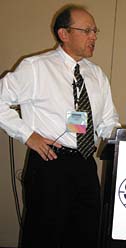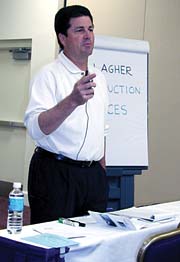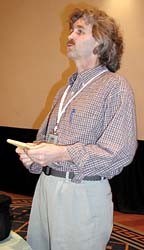Because the proceedings took place in our nation's capital, this explains, in part, why attendees bantered about politics. The fact that former Speaker of the House of Representatives, Newt Gingrich, was the opening general session speaker contributed to the case. Fueling the political fires were Sens. Mary L. Landrieu and Evan Bayh, who made brief speeches before the association presented its safety awards. And, of course, there were political overtones to the talk from Sheet Metal Workers' International Association (SMWIA) General President Michael Sullivan at the annual labor forum.
Then again, to think politics would not surface in Washington is similar to believing mold would not be discussed among a group of nearly 1,000 contractors. This year, SMACNA held two sessions specifically addressing mold. In fact, a third session was geared toward indoor air quality (IAQ), but talk eventually came right back to mold and how to prevent it.

Engineer's Perspective
In his talk "Mold and Moisture Control," Dennis Stanke, staff applications engineer for Trane, provided an engineer's perspective on what mold is, why it's a problem, and the risks involved for building owners. He also outlined some practical approaches to prevent mold and recommended what building owners should do if they encounter it."What's a designer to do?" asked Stanke. "It really comes down to two things. One, comply with the building code because it's the law. And, two, comply with ASHRAE 62 because it's the ventilation standard that is the basis for many building codes. And, it helps establish the designer's standard of care in the event of a legal struggle. The designer needs to show he was following the industry's standard of care in order to defend himself."
He encouraged the crowd of contractors to become well acquainted with ASHRAE Standard 62-2001, which is revised continuously by addenda. He pointed out that addendum 62n, now awaiting appeals, "makes significant changes to ventilation rates," noting that the ventilation rates "all go down a bit from 1989 levels."
In order to help contractors deal with, as well as eliminate, microbial growth, Stanke provided input about three types of microorganisms.
"It is small organisms of various kinds - for instance, bacteria; fungi, which includes mold; and dust mites," he said. "Mold seems to be the predominant problem in institutional and commercial buildings.
"Mold is a problem for several reasons. We know that people complain when they have a moldy building. Some can produce odors, allergens, and toxins. Since mold does this, we have to be careful around it. We know it can cause building damage, discomfort, and possibly illness. It turns out the research that is currently available in terms of mold and health implies ... well, it tells you for sure that damp buildings result in a higher incidence of health problems. It doesn't tell you for sure that mold results in a higher incidence of health problems. Moisture is the one thing we can control, or hope we can control."
The solution to stop mold depends on its location, he said. For instance, if it is in the air distribution system, Stanke called for contractors to avoid rain intrusion and entrainment, use mold-resistant surfaces, manage condensate from dehumidifying coil, and "drain pans must drain."
"Persistently wet surfaces due to carryover past the drain pan encourage microbial growth, so limit carryover," he said. "Persistently wet surfaces due to ‘spitting' drain lines and drain pan overflow encourage microbial growth, so seal the drain line properly."
In regard to managing condensate, Stanke preferred dual-slope drain pans. He also asked attendees to limit water droplet carryover due to pan length and due to high velocity. He said to avoid "spitting" (draw-through) units and overflow.
To reduce microbial growth in the building envelope, his checklist included:
"In humid climates, it's usually drier indoors than outdoors when you are cooling indoors," he said. "So that means, in the summer, you'd do well to push dry indoor air into the envelope. How do you do that? By pressurizing the building - by not relieving as much air from the building. You control relief airflow to encourage positive building pressure when cooling mechanically."
In humid and mixed climates, Stanke said the idea is to encourage water vapor in the envelope to diffuse to the indoors where the HVAC can remove it. "Don't use a vapor retarder on the inside of perimeter walls," he said.
In dry weather, Stanke called for the opposite airflow. During these times, usually winter, the idea is not to push moist indoor air into the envelope. At the same time, in cold climates the idea is to encourage water vapor in the envelope to diffuse to the outdoors where it's dry. In cold climates, Stanke encouraged the use of a vapor retarder on the inside of perimeter walls.
To reduce microbial growth in the occupied space, his checklist included:
"At all times, keep surfaces above dew point," he said. "When heating, keep walls warm and ensure good air circulation."
In the end, concluded Stanke, the HVAC system alone cannot prevent all moisture-related problems in buildings. Preventing mold problems in buildings and in HVAC systems is a shared responsibility among all parties involved in the design, specification, construction, commissioning, maintenance, and use of buildings, he said.

Don't Worry, Be Proactive
While Stanke preached awareness, Jim Berriatua of Gallagher Construction Services tried to put his crowd at ease regarding mold - even though the topic of his talk ("Mold Litigation: A Prevention Plan") hinted otherwise."Why are you here?" he asked attendees. "This mold stuff is nothing but hysteria."
In Berriatua's estimation, "This is all about one thing: Setting up a plan for you, a plan for you to avoid litigation related to mold."
If mold is such a health threat, he wondered, why are you allowed to dump the mold anywhere? He also wondered why there was no legal group responsible for overseeing any issues related to mold.
"So who is running the show here?" he asked, before quickly answering his own question. "Lawyers. Now, raise your hand if you like lawyers."
His remark did get a laugh, but not what he said afterward.
"I had a session just like this in Chicago," said Berriatua. "We had 100 contractors - 50 general contractors and 50 specialty contractors. My guest speaker was a lawyer. I got this guy to come and he sat there and stared them all in the eye and he said, ‘I am in the business of taking your assets.'"
The best way to combat this legal environment, he stressed, is to have an active management program to avoid litigation with respect to mold claims. He noted that, in his estimation, there is no current "medical proof anywhere that mold is associated with any sickness other than an allergy."
"You keep hearing that mold is the next asbestos," he said. "But has mold killed anyone? Excuse me, but when you inhale mold fibers, is it the same as inhaling asbestos fibers that stick to the inner linings of your lungs and that further develops if you are a smoker? No, no, no. Not even close."
Because Gallagher Construction Services is a division of Arthur J. Gallagher & Co., considered the fourth largest insurance broker in the world, Berriatua pointed out that "far more money" is going out for asbestos claims than mold claims.
"What is going to change all of this?" he asked. "The No. 1 change in all of this is you. What is going to take the hysteria away? Knowledge. And you get knowledge through education."
In December 2002, Berriatua said Gallagher Construction Services assembled 62 contractors from all over the country in a workshop to develop a written mold litigation prevention program. Additional workshop participants included insurers, attorneys, consultants, and owners. He said all participants were interested in a solution, not relying on input from insurance companies.
"If you are relying on insurance to help you on mold claims, you are in for a serious wakeup call," said Berriatua. "Insurance you buy today may not be any good to you in three years. The insurance you buy today, who knows if you can get it in a year."
The key issues in avoiding mold litigation, he said, are:
"The No. 1 preventive measure to avoid any chance of a claim against your company in the area of mold is a service agreement," said Berriatua. "Every single contractor I've ever spoken to, if they have a service agreement, they never have a mold claim. At the first sign of a problem, you should know before anyone else does. ... If you have a service agreement, you are way ahead of everyone else."
He said schools are the biggest offenders in regard to mold problems. And there is a valid reason, in his eyes.
"A thousand schools are shut down today because of mold problems, and it's because of lack of maintenance," he said.
He encouraged the crowd to educate the consumer. In the end, he said this is what is going to stop the hysteria.
"Education is not what sells newspapers," he said. "When is the last time you saw a real good educative piece in a newspaper to calm hysteria? You have to provide the education. It's not going to be easy."
To provide guidance, Berriatua said his company placed its Mold Litigation Prevention Program on its Web site, www.gallagherconstructionservices.com.
He encouraged attendees to review it and use appropriate contractual agreements placed on the site accordingly. To educate employees, he encouraged taking Web-based training classes offered on www.clicksafety.com.
"This can get way, way complicated, but let's not let it," he summarized. "You can get it to work for you. It's your turn to shine. You are in control. ... Three to five years, this mold hysteria is gone. It's up to you."

Residential Slant
At the Residential Contractors Forum, Terry Brennan of Camroden Associates Inc., supplied insight as to what residential contractors should know in regard to IAQ. While his talk, "Residential IAQ Issues - Challenges and Opportunities," did address IAQ issues, discussion eventually gravitated to mold prevention."Study the way air moves around a building," Brennan suggested. "This will tell you a lot."
In his estimation, the ways to prevent and solve IAQ problems include:
"If you have a building that is dry, clean, and pest-free, 85 percent of my cases would be gone," said Brennan. "That's why it is important to educate the homeowner."
He encouraged contractors to avoid installing ducts under slabs ("Just don't do it. You are just asking for mold problems."), avoid placing the air handler or return ducts in a garage, and avoid humidifiers. ("I hate them.")
"My experience with humidifiers is that they can be the cause of IAQ problems," he said. "I'd rather it be too dry than too wet in a home."
In his estimation, some of the things a contractor can do to improve IAQ are:
In regard to resources, Brennan encouraged attendees to visit www.buildingsciences.com. There, he said, a contractor can find material to help the homeowner understand IAQ matters and mold prevention.
Publication date: 11/10/2003

Report Abusive Comment